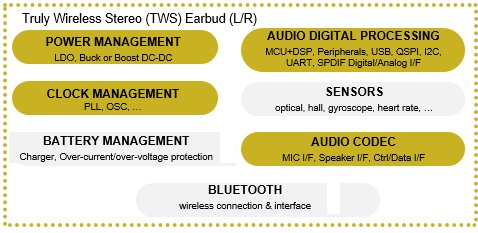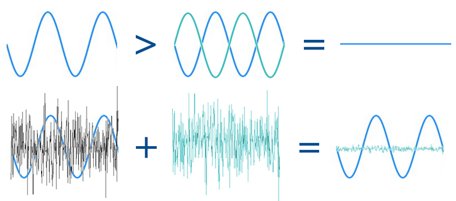Paving the way for the next generation audio codec for True Wireless Stereo (TWS) applications - PART 3 : Optimizing latency key factor
By Hai YU, Clément MOULIN (Dolphin Design)
In this third part of Paving the way for the next generation audio codec for the True Wireless Stereo (TWS) applications whitepaper, the latency performance and how it impacts the ANC performance will be detailed.
Figure 1 highlights the functions under discussion amongst the main functionalities embedded in earbuds.

Fig. 1: Functional blocks of a typical TWS chip (earbud chip only)
There are two types of noise-cancellation methods in TWS earbuds or headphones, passive and active, and both can be used separately or together. Passive noise-cancellation (also known as noise isolation) filters out the ambient noise with components of the headphone, such as rubber tips or padding, which is effective at high-frequency noise (audio bandwidth above 1 kHz), but not at low-frequency ambient noise. Active noise-cancellation, on the other hand, is more effective in dealing with constant, repetitive low-frequency noise, such as the buzzing sound of an airplane engine or the humming noise of a refrigerator. In this section, we will mainly focus on the active noise-cancellation technology in TWS system.
Active noise-cancellation (ANC) was originally developed to reduce the static noise of engines on flights. Nowadays, more powerful algorithms and better microphones have pushed ANC beyond the world of travel, enabling users to eliminate background noise and voices in the office and at home. It is even a feature in today’s TWS headsets. Beamforming with microphone arrays enables people to have clear conversations, whether they are working from home or in a noisy environment. Active noise-cancellation (ANC) technology enables a new era of audio devices in wireless and true wireless earbud designs.
The principle of noise cancellation is that the microphone collects external environmental noise, and then the system transforms it into an inverse sound wave and adds it to the speaker end, thereby reducing sensory noise. There are different ways to design and implement the ANC technology in TWS oriented applications: Feedforward ANC, Feedback ANC, and Hybrid ANC.

Fig. 2: Active Noise Cancelling (ANC) principle
1- Active Noise Cancellation (ANC) Technologies
With feedforward technology (or FF), the noise capturing microphone(s) is placed on the outside of the headphones. Feedforward ANC uses a digital signal processor (DSP) or other dedicated ANC processing hardware to map the noise signal to the frequency response the user will hear on the inside of the headphones. The feedforward technology operates efficiently from about 80 Hz to 2 kHz of the audio bandwidth.
Feedback (or FB) ANC is the opposite of feedforward, with the microphone placed inside the ear cup or inside the wearer’s ear with earbuds. The major benefit is that noise captured by the microphone more accurately reflects the noise the wearer hears, regardless of the exact positioning and fit of the headphones. As with all feedback systems, there is a small risk of runaway amplification. There is a small risk of the system picking up its own anti-noise signal and increasing the level of amplification in a bid to cancel it out, but actually increasing the amount of noise or even producing a ringing feedback sound. Another benefit is that there is less processing time, as it is working on audio already very close to the ear. The feedback technology operates efficiently from about 50 Hz to 800 Hz of the audio bandwidth.
Hybrid ANC offers the best of both worlds, it combines both FF and FB microphones and processing to cover all bases. Consequently, hybrid ANC achieves the best noise attenuation frequency coverage and the lowest chance of feedback issues. The drawback is that hybrid ANC is more expensive. Not only are there two microphones but these microphones need to be of high quality to avoid introducing extra noise. Furthermore, the headphones require more powerful dedicated processing hardware to handle the complex data processing, which will increase the ANC software or algorithm development costs.
But here comes the question, how do the different ANC technologies matter when selecting the audio codec IP for the TWS earbuds or headphone?
Before answering this question, we will discuss the ANC technology design challenges in TWS targeted applications.
- Very restricted audio latency of the digital filters (input-to-output or analog-to-analog).
- Real-time audio sample-based streaming (that is, one audio sample in, one audio sample out).
- Resource-constrained for the large amount of audio data processing.
- Extreme-low power, low input-to-output latency, and high sampling rate both for ADC and DAC.
2) Input-to-output latency
We use a simple example to explain the relationship between audio latency and the ANC algorithm. An audio codec with ADC/DAC sampling rate (Fs) of 192 kHz, (that is, one audio sample equals 1 / 192,000 secs) should be finished in 800 clock cycles (5 µs / (1000 / 160 MHz) = 800 cycles). Furthermore, to have the most effective ANC for noise cancellation, you need to use the highest filter tap number. If we say that 128 (27) taps are used for the addition and multiplication operations, it means that it requires 896 additions and 896 multiplications for only one audio sample. It thus needs in total 384 MACs for only 1 audio sample if FF or FB ANC algorithm is used; or 896 MACs for only 1 audio sample if hybrid ANC is used. Consequently, the input-2-output latency plays a key role for the ANC algorithm efficiency (we assume that the MCU or DSP frequency is fixed).
There are two aspects to be taken into consideration. On the one hand, we want to enable a fully Feedforward, Feedback or Hybrid implementation which combines the best of both worlds by providing high performance ANC while maximizing the audio quality and battery life. With high performance audio recording and the audio playback paths, the audio codec IP is designed for minimum latency, especially of digital filters, which thus allows superior ANC performance and audio quality. On the other hand, if the “anti-noise” mirror signal cancels the ambient noise in an efficient manner, the DSP will not necessarily need to work at full speed when executing the ANC software, which leads to further power consumption optimization.
| Dolphin Design’s low latency CODEC Dolphin has designed the digital filtering specifically for TWS audio applications, keeping analog-to-digital audio recording path latency down to 3 µs with a similar latency for the digital-to-analog playback path. Consequently, the ANC optimized digital filter design enables an I/O latency of just 6 to 8 µs. This ultra-low I/O latency, dramatically eases the ANC software development, providing more design margins, and enhancing the power efficiency of the signal/noise processing workload. In addition, the digital filters can be programmed to balance the filtering and latency response, including band ripple and out-of-band attenuation efficiency. This flexibility and programmability allows the parameterizable digital filtering to optimize TWS audio scenarios. |
ABOUT THE AUTHORS
Hai YU received his PhD in Nano and Micro Electrical Engineering in 2011 from TIMA laboratory, Grenoble Alpes University for his work on low-cost highly efficient fault tolerant processor design for mitigating the reliability issues in nanometric technologies. Hai joined Dolphin Design in 2012 and is currently working as a Lead Application Engineer, focusing on Audio & Processing IPs platforms.
Clément MOULIN graduated from ENSEEIHT Toulouse in electronic and signal processing in 2006. After 8 years of leading hardware development in NFC domain, Clément joined Dolphin Design in 2020 and is currently working as an Application Engineer, focusing on Audio & Processing IPs platforms.
Related Semiconductor IP
- Audio CODEC
- Parallel to AXI5 Bridge for Audio CODEC
- 24-Bit Stereo Audio Codec ADC, ADC SNR>95dB, DAC SNR>100dB - SMIC 55nm
- 24-Bit Stereo Audio Codec ADC, ADC SNR>95dB, DAC SNR>100dB - SMIC 40nm
- 24-Bit Stereo Audio Codec ADC, ADC SNR>95dB, DAC SNR>100dB - UMC 55nm
Related Articles
- Timing key to optimizing audio performance in consumer products
- Paving the way for the next generation audio codec for the True Wireless Stereo (TWS) applications - PART 1 : TWS challenges explained
- Paving the way for the next generation audio codec for True Wireless Stereo (TWS) applications - PART 2 : Increasing play time
- Paving the way for the next generation audio codec for TRUE Wireless Stereo (TWS) applications - PART 4 : Achieving the ultimate audio experience
Latest Articles
- Extending and Accelerating Inner Product Masking with Fault Detection via Instruction Set Extension
- ioPUF+: A PUF Based on I/O Pull-Up/Down Resistors for Secret Key Generation in IoT Nodes
- In-Situ Encryption of Single-Transistor Nonvolatile Memories without Density Loss
- David vs. Goliath: Can Small Models Win Big with Agentic AI in Hardware Design?
- RoMe: Row Granularity Access Memory System for Large Language Models